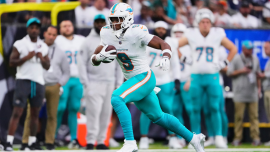Last month, we finally got word that the long-rumored union between Aaron Rodgers and the Pittsburgh Steelers was actually happening. Rodgers signed a one-year, $13.6 million contract, to play what he claims is his final season, for Pittsburgh.
That means this is no longer theoretical, so it’s time to do some speculating about what things could actually look like when the Steelers take the field. We know who will be involved in the proceedings, and we also have a decent idea of what things will look like structurally thanks to what we know about both Rodgers’ history and that of offensive coordinator Arthur Smith.
But what the marriage of all those things will look like when they come together, nobody yet knows. So, let’s walk through all the principals involved and try to make some educated guesses about how this is all going to work.
Offensive coordinator: Arthur Smith
Smith has a pretty extensive track record of calling plays. He was the offensive coordinator for for two years with the Tennessee Titans (notably having taken over the role from Green Bay Packers head coach Matt LaFleur), a play-calling head coach for three years with the Atlanta Falcons and then the offensive coordinator for the Steelers last year.
- We know that his teams tend to be run-heavy. His Falcons ranked fifth in the NFL in called run rate during his three seasons there, per Tru Media, while the Titans ranked second during his two seasons as OC and the Steelers checked in fourth last year.
- We know that Smith likes to use a ton of motion either before or at the snap: he used it on 51.5% of his team’s offensive plays during his three years as a coordinator and 57.3% of plays during his three years as a head coach.
- We know that he likes — nay, loves — multi-tight end sets. The Falcons used two or more tight ends on 48% of their plays during Smith’s tenure, while his Titans and Steelers teams used multiple tight ends on 42% of their snaps.
We also know that not much of that aligns with what Rodgers’ offenses have typically looked like during his career.
- Rodgers has typically operated pass-heavy offenses (59% called pass rate), which held true both under LaFleur (57.5%) and last year in New York (63.2%).
- We know that Rodgers typically doesn’t like when his teams use motion at the snap because he wants to be able to read a set defense, though he did deal with an uptick in motion usage both under LaFleur (48.8%) and last year with the Jets (44.3%).
- We also know that Rodgers’ offenses didn’t rely much on multi-tight end sets, with the Packers and Jets using them only 23% of the time, though that did tick up to 30% under LaFleur.
But we’ve also already seen what it looks like when Rodgers hooks up with a play-caller with this style of offense — or at least, what it can look like, in ways both good and bad.
As mentioned, Smith took over play-calling duties in Tennessee after LaFleur left to become Green Bay’s head coach. Smith was previously the tight ends coach for the Titans, spending the 2018 season working under LaFleur, and their offenses do bear at least some similarities to each other. And for a few years, dropping Rodgers into LaFleur’s offense worked like gangbusters, to the tune of two NFL MVP seasons and a whole lot of wins. But Nathaniel Hackett worked for several years under LaFleur in Green Bay, and we saw what that looked like last year in New York. It wasn’t pretty.
There’s a pretty wide disparity in how this type of union can go, and a lot of it depends on whether or not Rodgers actually wants to play inside the structure of the offense — which he only occasionally wants to do, and when he doesn’t, he makes very little secret of it and actively looks to break things, which can undermine the entire operation.
Why Bill Cowher believes Steelers should give Aaron Rodgers full autonomy on offense
Cody Nagel
Looking back at the history of Rodgers’ teams in Green Bay, they often had a thunder-and-lightning duo in the backfield. They had guys like Aaron Jones and Ryan Grant and James Starks, but also guys like Eddie Lacy and Jamaal Williams and AJ Dillon.
Looking at this year’s Steelers, they could have something of a similar setup, with Jaylen Warren in the Jones-esque role and third-round pick Kaleb Johnson playing the Williams/Dillon role. Warren is smaller, shiftier and great in the passing game. Johnson is a bigger back (225 pounds) who is more of a one-cut, zone-blocking scheme runner.
It’s worth noting that Smith has also shown a preference for bigger backs, thought some of that is just that he had Derrick Henry in Tennessee, Tyler Allgeier (and Bijan Robinson) in Atlanta and then Najee Harris last year in Pittsburgh.
Still, there should be a significant role available for Johnson, even if only because through his three years in Pittsburgh, multiple offensive coaching staffs saw Warren consistently out-perform Harris on a per-carry basis and still showed reluctance to give him the lion’s share of the work, likely at least in part due to his size. Meanwhile, Warren should be a valuable asset in the passing game, as Rodgers has shown a propensity to use his backs as underneath outlets on both check-downs and swing passes — and we know he can be efficient when given work on the ground.
Pittsburgh’s wide receiver corps leaves a lot to be desired, which is going to make things extremely interesting given how interested Rodgers typically is in operating pass-happy offenses.
Metcalf is a good player in the body of a true No. 1 X receiver, but he doesn’t earn targets that way (he’s been targeted on only 21.8% of his career routes, via Tru Media, which is right in line with Tee Higgins, by way of example). He’s not quite as efficient as those guys, either (1.90 career yards per route run, which is just shy of the 2.00 benchmark that typifies a No. 1 receiver and is on par with another No. 2 in DeVonta Smith).
He also doesn’t always play to his size, which could make for an interesting fit with Rodgers, who loves firing the ball into tight spaces and trusting his receiver to come down with it. How they mesh on things like back-shoulder throws, option routes (Metcalf had several miscommunications with Geno Smith over the last couple years) and go balls should be very interesting to watch. He’s not going to be on the level of Davante Adams or even Jordy Nelson, in all likelihood, but if he can get something like 75% of the way there, the Steelers would probably be very happy.
But Metcalf is also the least of Pittsburgh’s concerns. The rest of the receiving corps is pretty bleak. Woods has looked washed for a couple years now. Wilson was injured and played just five snaps as a rookie. Austin has 53 catches for 728 yards in two NFL seasons, during which he’s run just 53% of possible routes and been targeted only 14.6% of the time he’s gone out on a pass play, generating an anemic 1.21 yards per route run.
Can Austin fill a Randall Cobb-esque slot role? Maybe in the absolute best-case scenario, but it’s definitely a lofty projection and one that’s unlikely to work out that well for Pittsburgh. The best bet for a secondary receiving option is probably Wilson having a second-year breakout after hardly playing at all as a rookie.
As previously mentioned, Smith LOVES playing multiple tight ends. This is probably the actual path to getting more receiving production than the Steelers can reasonably get out of their wideouts.
Smith is a longtime Smith favorite whom he had in both Tennessee and Atlanta. He and Freiermuth probably make for a somewhat similar pairing to Smith and Kyle Pitts with the Falcons, while Washington can serve in the blocking tight end role that often fell to Marcedes Lewis on Rodgers’ Packers teams and guys like MyCole Pruitt and Lee Smith for Smith’s teams in Tennessee in Atlanta.
The Steelers are really going to need Smith and Freiermuth to work well as options on both underneath passes and especially stretching the field vertically up the seams, thought it’ll be interesting to watch how often Smith actually plays them together rather than one of them with either Washington or Heyward, given how much he likes having a blocker on the field.
Steelers acquire Jonnu Smith from Dolphins: Why he helps Aaron Rodgers as do-it-all weapon
Zachary Pereles

Realistically, this is probably the most important part of the team. The Jets offensive line was … not good last season, and it had a dramatic effect on Rodgers’ play. To get the best out of him, he has to be willing to set in the pocket and let plays develop rather than cutting things off with an immediate underneath throw or a performative deep ball thrown before the receiver even has a chance to get downfield and beat his man on the route. (He engineered for himself the NFL’s fifth-lowest pressure rate last season despite playing behind a poor offensive line, simply by often getting rid of the ball before plays had a chance to develop.)
The Packers often had fantastic offensive lines throughout Rodgers’ career, and it helped him reach the heights his talent probably ensured that he was going to reach anyway. At his age and in his diminished capacity, though, he needs to be far better protected than he was last year, especially because he’s no longer mobile enough to either run away from pressure or truly create all that much outside of structure. This group needs to play at an extremely high level.



